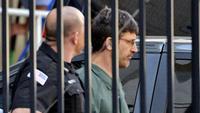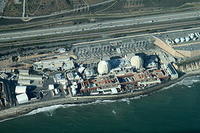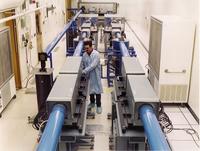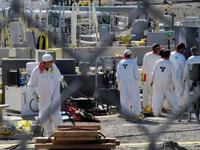-
Two men charged with planning an “X-ray weapon’’ to kill Muslim enemies of U.S., Israel

Two men from upstate New York were charged Wednesday with a scheme to build an X-ray weapon to kill Muslim enemies of the United States and Israel. They planned the weapon to kill the designated targets with lethal radiation, and some of the targets were to be killed in their sleep. The indictment says the two wanted to build a powerful X-ray device that could be placed in a truck and driven near a target. The driver would park, leave the area, and activate the device, “killing human targets silently and from a distance with lethal doses of radiation.”
-
-
U.K. nuclear disaster exercise reveals worrisome lapses in emergency response
Up to six times a year, U.K. nuclear weapons are transported in heavily guarded convoys between production facilities in Aldermaston and Burghfield in Berkshire, where the nuclear bombs are manufactured, and the Royal Naval Armaments Depot at Coulport on Loch Long in Argyll. The trips are required because scientists must regularly examine the 200 Trident missile warheads in order to make sure they are operationally reliable and properly maintained. Every three years, the U.K. Ministry of Defense (MoD) conducts a drill aiming to test how various agencies respond to an accident involving the convoy carrying the nuclear warheads. An internal report on the last drill notes many problems in the response to the simulated accident, including five-hour wait for weapons experts, confusion over radiation monitoring, and ambulance crews refusing to take contamination victims to hospitals.
-
-
California’s San Onofre nuclear power plant retired due to safety concerns

Southern California Edison (SCE) has decided it will retire the San Onofre nuclear power plant located on the California coast. The decision comes after officials debated for over a year whether the twin reactors could be safely restarted. The power plant is located in a populated area, with millions living near it.
-
-
Laser-driven neutrons to detect nuclear smuggling

Researchers have successfully demonstrated for the first time that laser-generated neutrons can be enlisted as a useful tool in the war on terror, as Los Alamos shows first nuclear material detection by single short-pulse-laser-driven neutron source.
-
-
Fukushima-derived radioactivity in seafood poses minimal health risks
Researchers find that the likely doses of radioactivity ingested by humans consuming fish contaminated by radioactive radiation escaping from the debilitated Fukushima reactors fish, are comparable to, or less than, the radiological dosages associated with other commonly consumed foods, many medical treatments, air travel, and other background sources.
-
-
Health impact of Chernobyl accident overestimated: study

The impact of the Chernobyl nuclear accident has been seriously overestimated, while unfounded statements presented as scientific facts have been used to strangle the nuclear industry, according to Russian researchers.
-
-
Reducing the volume of nuclear waste
The nuclear industry seeks to minimize the volume of nuclear waste by extracting the radioactive elements from spent fuel.This relies on exploiting differences in the chemical bonding of uranium. Scientists have found that in some circumstances the bonding may be surprisingly similar, an important discovery which is going to be important in the amelioration of nuclear waste clean-up and devising new atom-efficient catalytic cycles.
-
-
Energy Department to invest in used nuclear fuel storage research
As part of its efforts to develop an effective strategy for the safe and secure storage and management of used nuclear fuel, the Energy Department the other day announced a new dry storage research and development project. In the Energy Department’s budget request presented last week, the department requested $60 million for nuclear waste research and development.
-
-
Former NRC chairman: all 104 U.S. nuclear reactors suffer from “irreparable” safety issues
According to former U.S. Nuclear Regulatory Commission (NRC) chairman Gregory Jaczko, all 104 nuclear reactors in the United States currently have irreparable safety issues and should be shut down and replaced. Jaczko was the NRC chairman from 2009 through 2012.
-
-
Critics: Fukushima-influenced U.S. nuclear accident response procedures are flawed
The U.S. government is using the Fukushima nuclear disaster in Japan two years ago as a model for rewriting its plans on how to respond to radiation contamination — emphasizing long-term cleanup and return of residents to affected areas instead of emergency response. Critics say this is a mistake.
-
-
U.S. nuclear industry faces a wave of nuclear power station retirements
A wave of U.S. nuclear power station retirements is on the horizon. The typical design life of a nuclear power plant is 40 years. There are 104 nuclear power plants in the United States, and their average age is 34 years — only a few years short of, and fast approaching, their design life. Almost 30 U.S. commercial and research reactors already have started decommissioning. A $400 million is regarded as the bargain basement price tag for cleaning up a single reactor.
-
-
Ohio’s Perry nuclear power plant was vulnerable to sabotage
A report issued last week said that operators at the Perry Nuclear Power Plant in Ohio found a vulnerability in the security of the plant last year, and that that vulnerability could have put the public in harm’s way. The utility operating the nuclear plant reported to the Nuclear Regulatory Commission (NRC) that the plant’s security program for monitoring underground pathways and other unattended openings were insufficient to detect and prevent unauthorized access to the protected area.
-
-
New radioactive waste repackaging facility in Los Alamos
The Los Alamos National Laboratory has brought a third waste repackaging facility online to increase its capability to process nuclear waste for permanent disposal. The box line facility is largest of its kind ever built.
-
-
U.S. nuclear industry resists stricter, post-Fukushima safety measures
Since the March 2011 Fukushima disaster, members of the Nuclear Regulatory Commission (NRC) have been debating whether or not to impose even stricter safety measures on the thirty-one U.S. boiling water reactors (BWRs). Utility companies have been fighting any new safety regulations, arguing that the security measures they have are more than enough.
-
-
Radioactive leaks at Washington’s Hanford nuclear reservation

Earlier this month, Washington Governor Jay Inslee announced that a radioactive waste tank at one of the nation’s most contaminated nuclear sites is leaking, bringing more bad news to Washington’s Hanford nuclear reservation. The 177 tanks at the plant, which hold millions of gallons of highly radioactive waste from plutonium production, are way past their intended 20-year life span.
-
- All
- Regional
- Water
- Biometrics
- Borders/Immig
- Business
- Cybersecurity
- Detection
- Disasters
- Government
- Infrastructure
- International
- Public health
- Public Safety
- Communication interoperabillity
- Emergency services
- Emergency medical services
- Fire
- First response
- IEDs
- Law Enforcement
- Law Enforcement Technology
- Military technology
- Nonlethal weapons
- Nuclear weapons
- Personal protection equipment
- Police
- Notification /alert systems
- Situational awareness
- Weapons systems
- Sci-Tech
- Sector Reports
- Surveillance
- Transportation
Advertising & Marketing: advertise@newswirepubs.com
Editorial: editor@newswirepubs.com
General: info@newswirepubs.com
2010-2011 © News Wire Publications, LLC News Wire Publications, LLC
220 Old Country Road | Suite 200 | Mineola | New York | 11501
Permissions and Policies
Editorial: editor@newswirepubs.com
General: info@newswirepubs.com
2010-2011 © News Wire Publications, LLC News Wire Publications, LLC
220 Old Country Road | Suite 200 | Mineola | New York | 11501
Permissions and Policies
